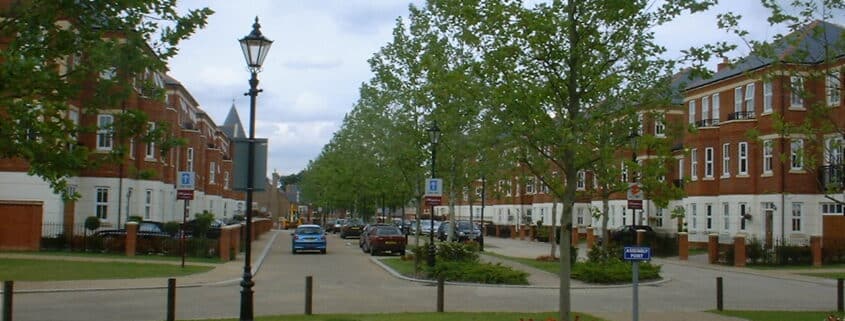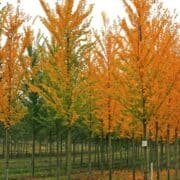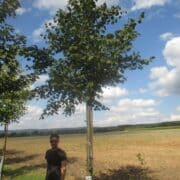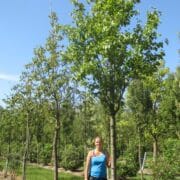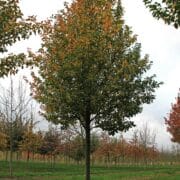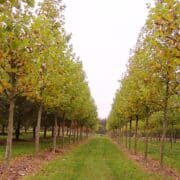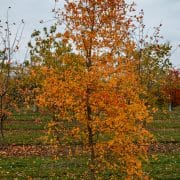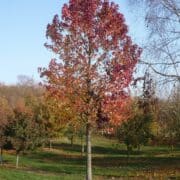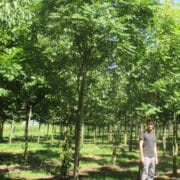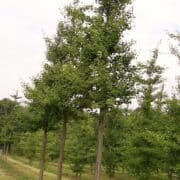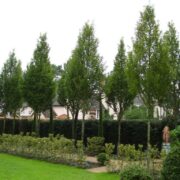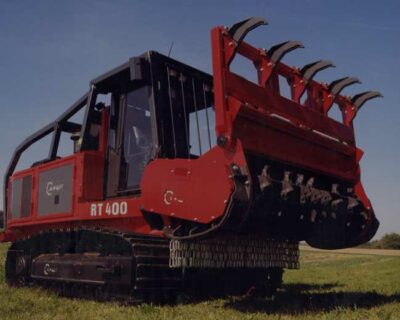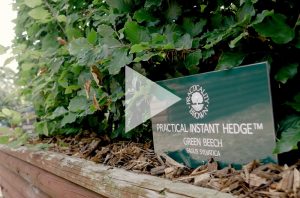Trees for Urban Areas
Trees can enhance all environments, even urban ones with a wide range of environmental, social and economic benefits; street trees in urban parks have been found to improve physical and mental health, improve aesthetics and environmental quality, which can lead to increased investment and the local economy.
Our list of the best trees for urban planting are as follows: (originally featured in magazine FutureArc)
- Carpinus betulus Frans Fontaine (Upright Hornbeam)
- Ginkgo biloba (Maidenhair Tree)
- Koelreuteria paniculata (Golden Rain Trees)
- Liquidambar styraciflua (American Sweet Gum)
- Nyssa sylvatica (Sour Gum)
- Platanus× acerifolia (Plane Trees)
- Pyrus calleryana Chanticleer (Callery Pear)
- Sorbus torminalis (Wild Service Trees)
- Tilia cordata (Small-leaved Lime)
- Ulmus hollandica Lobel (Lobel Elm)
See Forestry Commission article for more details on street tree planting programmes.
Top 10 Street Trees
Carpinus betulus Frans Fontaine (Upright Hornbeam)
Distinctive features: Bright green foliage in the spring, turning to gold and orange in the autumn. It tolerates pollution and soil compaction, making it an excellent choice for street tree planting. Upright Hornbeam will do well in most soils, including clay and chalk. It is a good choice for poor soil conditions.
Average height/ crown size: 20m Retains its columnar shaped crown of only 3m
Maintenance/Planting tips: 20-25years to maturity; will tolerate most soil types
Ginkgo biloba (Maidenhair Tree)
Distinctive features: The leaves are fan shaped, appearing bright green in spring and then bright yellow in the autumn. Tough enough to cope with air pollution, reflected heat and light, Ginkgo biloba is a great contender as a street tree.
Average height/ crown size: 20m+ forms a large specimen with a conical shape at maturity
Maintenance/Planting tips: 20-50years to maturity; will tolerate most soil types
Koelreuteria paniculata (Golden Rain Trees)
Distinctive features: Koelreuteria paniculata’s profuse small yellow flowers develop in late spring and these form lantern-shaped fruits that turn red in the autumn when its green leaves turn a rich yellow.
Average height/ crown size: 7-12m forms a rounded crown
Maintenance/Planting tips: 20-50 years to maturity; thrives best on free draining soils with a sunny aspect.
Liquidambar styraciflua (American Sweet Gum)
Distinctive features: Liquidambar styraciflua or American Sweet Gum is a large, undemanding tree, which is pollution resistant. It’s large star-shaped leaves emerge bright green in the spring then changing to fabulous red, purple and gold colours throughout the autumn; Liquidambar is one of the very best trees for autumn colour and one of the last deciduous trees to drop its leaves.
Average height/ crown size: 20m+ matures to a rounded crown
Maintenance/Planting tips: more than 50 years to maturity; Best in fertile, well-drained soil, not suitable for lime or chalky soils
Nyssa sylvatica (Sour Gum)
Distinctive features: The Tupelo or sour gum is a wonderful tree for autumn foliage with its green summer leaves turning yellow, orange and even red into late autumn
Average height/ crown size: 12-17m Pyramidal in habit when young, it can develop into a large broad tree at maturity
Maintenance/Planting tips: 20-50 years to maturity; requires free draining acid soil
Platanus × acerifolia (Plane Trees)
Distinctive features: The London Plane is the classic street tree, due to its high tolerance of pollution; It is also known as Platanus × hispanica. This large tree features multi-coloured, flaking bark, which includes patches of white, green, grey and brown. It’s large shiny, dark green leaves, transform into a copper colour in autumn before falling
Average height/ crown size: 20-30m forms a broadly pyramidal shaped crown at maturity
Maintenance/Planting tips: 20-50 years to maturity; tolerant to all soils but thrives
Pyrus calleryana Chanticleer (Callery Pear)
Distinctive features: A medium height tree, the glossy lush green leaves emerge in March and last through to November, when they change to a reddish-purple before falling. It’s a very hardy tree, resistant to frost, heat, wind and pollution
Average height/ crown size: 15m side branches stretching upwards creating a narrow, conical shape
Maintenance/Planting tips: 20-50 years to maturity; Prefers to be in full sun, adapts well to most soils
Sorbus torminalis (Wild Service Trees)
Distinctive features: This has white flowers in spring give way to sharp tasting fruits in the autumn whilst its bark resembles a chequer pattern as it matures. Its green summer leaves turn orange and yellow in the autumn
Average height/ crown size: 10-15m a columnar habit when young and graduates to a broad oval when mature.
Maintenance/Planting tips: 20-50 years to maturity; thrives in most free draining soils, not in full sun, it is tolerant of atmospheric pollution and dry conditions.
Tilia cordata (Small-leaved Lime)
Distinctive features: This native tree produces fragrant white flowers in mid-summer and is a good tree for attracting bees and the yellow leaf colour in autumn is attractive. An excellent choice for avenues and parks.
Average height/ crown size: 20–30m a broad oval crown
Maintenance/Planting tips: 20-50 years to maturity; It tolerates heat, is frost hardy and wind resistant, but is sensitive to salt. This tree is happy on most soils
Ulmus hollandica Lobel (Lobel Elm)
Distinctive features: The fairly small rough leaves are dull dark green with dense veins and a double-serrated edge. They are bronze coloured when they emerge, remaining on the tree for a long time, often until late November. It is very resistant to sea wind, making it suitable for use in coastal areas.
Average height/ crown size: 20-30m pyramidal tree with a dense crown
Maintenance/Planting tips: 20-50 years to maturity; It favours moist and light soils.
- Ulmus hollandica Lobel autumn
- Tilia cordata
- Sorbus torminalis
- Pyrus calleryana Chanticleer
- Platanus acerifolia (London plane)
- Nyssa sylvatica
- Liquidambar styraciflua
- Koelreuteria paniculata (golden rain tree)
- Ginkgo biloba (Maidenhair tree)
- Carpinus betulus Frans Fontaine

